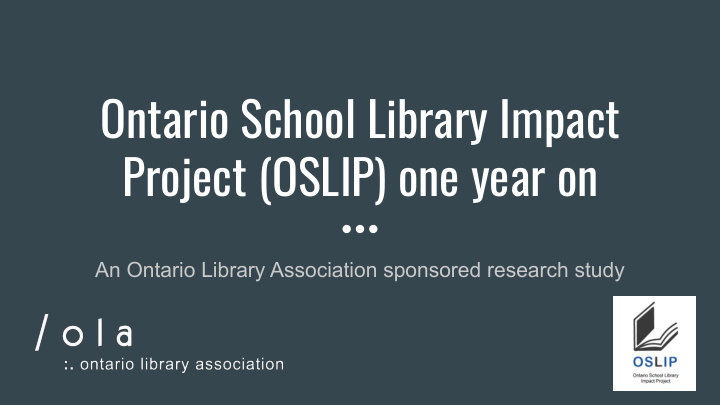



Ontario School Library Impact Project (OSLIP) one year on An Ontario Library Association sponsored research study
Introductions Marc d’Avernas Mary Cavanagh Sarah Roberts Waterloo Region DSB University of Ottawa (now Mount Royal Ontario Library Association University) Heather Buchansky Dianne Oberg Kate Johnson-McGregor University of Toronto University of Alberta Grand Erie DSB Libraries (retired)
Timeline OLA Super Conference 2016 Winter 2016 Spring 2018 OLA brainstorming session Summer 2018 Model developed, calls to members November 2018 OSLIP formed OLA school libraries inventory released Early 2019 Fall 2019 OSLIP questionnaire launched
OLA School Library Inventory Purpose: To collect data on the state of school libraries across the province to complement the benchmarking that People for Education is doing in their Annual Reports on Schools Response rate: 551 responses from 57 school boards (out of 78 total)
OLA School Library Inventory - challenges ● No data from closed libraries ● Difficult to reach all library staff ● Library bias in respondents
OLA School Library Inventory - findings ● Northern Ontario challenges ● Elementary vs. secondary staffing ● Inconsistency between and within boards
OSLIP goals ● Investigate impact of school libraries in developing information literacy skills ● Create reproducible research model ● Share findings to support advocacy
OSLIP structure Core ● OSLIP Core Project Team ● OSLIP Advisory Committee Advisory PGI Cmte. ● Student research consultants funded through the University of Toronto’s Munk School of Global Affairs & Public Policy, Public Good Initiative (PGI)
University partners Institutional participation criteria: ● Geographical distribution; ● Size of institution; ● Diverse types of student populations as much as possible; ● Participating academic librarians to coordinate on site Convenience sample: University of Toronto, University of Windsor, and Nipissing University
Research gaps ● Reductions in funding, fewer teacher-librarians, closures (Fiore, 2017) ● Lack of research on long-term school library impact Critical 21 st century competencies ● (reading/writing, critical thinking, analysis) ● The role of the library/librarian
Information Literacy for high school students 30 years of school library impact studies: ● “School library research summarized: A graduate class project” Kachel, 2013; ● “Why school librarians matter: What years of research tell us” Lance & Kachel, 2018; ● “Connecting British Columbia (Canada) school libraries and student achievement: A comparison of higher and lower performing schools with similar overall funding” Haycock, 2011
Information Literacy for university students ● “A call to action: Academic skill deficiencies in four Ontario universities” Grayson et al, 2019; ● Information literacy proficiency: Assessing the gap in high school students’ readiness for undergraduate academic work” Smith, Given, Julien, Ouellette, & DeLong, 2013; 21 st Century Competencies , 2016 ● ● “College success: High school librarians make the difference” Smalley, 2004; ● “Broken links: Undergraduates look back on their experiences with information literacy in K-12 education” Latham and Gross, 2008; ● “Learning the ropes: How freshman conduct course research once they enter college” Head, 2013
Research questions What information literacies do 1 st year Ontario university 1. students have at the start of their academic careers? How do 1 st year university students’ experiences of IL / 2. inquiry-based learning and instruction via their secondary school libraries (staff, collections, spaces) influence their IL / inquiry-based learning assessment in 1st year university?
Working assumption Previous access to secondary school libraries with concurrent information literacy (IL) instruction by teacher-librarians among 1 st year Ontario university students positively impacts their initial undergraduate IL skills and competencies.
Concept Map: Inquiry <-> Questionnaire <-> ACRL Framework
Research ethics ● Submission ● Application process ● Guiding policy statement: ○ Tri-Council Policy Statement 2 - Ethical Conduct For Research Involving Human Subjects
Survey Design ● Frameworks ○ ACRL ○ Ontario Model of Inquiry ● Testing and feedback ○ Advisory group ○ Secondary school students ● Reproducibility
Preliminary impressions University # of # of open-ended respondents responses (Q #13) Nipissing 114 66 Toronto 44 23 Windsor 64 32 TOTAL 222 121
Preliminary Impressions “Did you receive library instruction from a teacher-librarian in your last year of high school?” University # responding “Yes” % responding “Yes” Nipissing 24 35.29% Toronto 9 39.13% Windsor 3 9.09%
Preliminary impressions Positive Negative ● Valued the library as a quiet place for study, a resource for completing assignments, projects, ● Never used the library for help source of materials related to personal interests (2 comments) (10 comments) ● Very boring but helpful to learn ● Found librarians to be helpful & friendly (1 comment) (6 comments) ● Teachers assisted with library-related activities (2 comments) ● Reported they learned how to find reliable sources; how to use database & library catalogues (22 comments)
Early observations ● School-organized information literacy sessions provided by university librarians and public librarians ● No library facility in some schools
OSLIP challenges ● Difficulties of getting a large number of responses ● Differences among the universities’ ability to engage respondents ● Self-assessment as a data collection method ● Resources not available to conduct an experimental (pre/post-tests) design to formally measure student capabilities
Next steps Winter 2020 ● Repeat survey in late winter at same institutions Conduct qualitative interviews at each site ● Fall 2020 ● Present preliminary findings to Advisory Committee for confirmation, and feedback ● Prepare and submit final report
Questions?
Recommend
More recommend